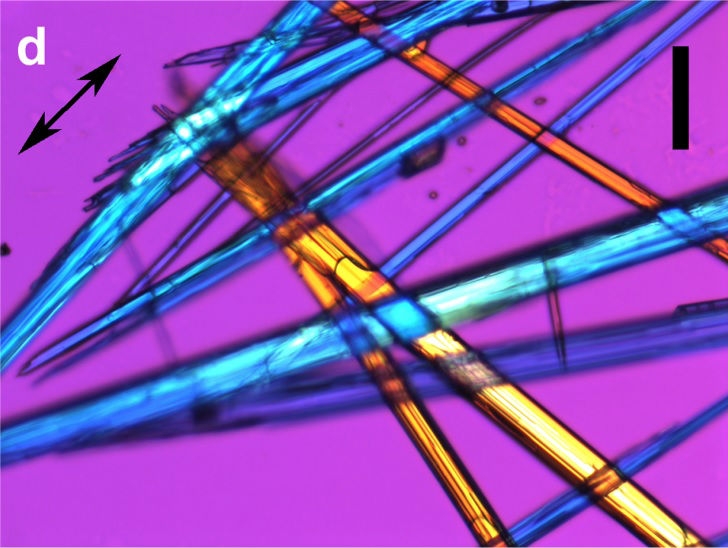


Brazilian research group shows that valproic acid (VPA), used to treat epilepsy since the 1960s, modulates gene expression in tumor gene models and acts on DNA conformation and the histones in chromatin (polarized light view of sodium valproate crystals / International Journal of Biological Macromolecules)
Published on 03/18/2021
By Chloé Pinheiro | Agência FAPESP – Results of recent studies involving valproic acid, used for decades as an anti-convulsant drug, show that it can interact with the conformation of DNA and regulate gene expression.
These are some of the key findings from a project led by biologist Maria Luiza S. Mello at the University of Campinas (UNICAMP) in the state São Paulo, Brazil, with the collaboration of Benedicto de Campos Vidal, Emeritus Professor in the Biology Institute’s Department of Structural and Functional Biology.
The group has been studying the functions of valproic acid, or sodium valproate (VPA), for over a decade and have demonstrated the compound’s action on the expression of genes associated with diabetes in cellular models (read more at: agencia.fapesp.br/23819).
Its interaction with DNA is reported in an article published in the International Journal of Biological Macromolecules. The study was part of a Thematic Project supported by FAPESP to study the action of VPA. “Elucidating the drug’s action mechanisms is important because it paves the way for novel pharmaceutical research,” Mello said.
Changes in histones and DNA
The epigenetic action of VPA – its capacity to influence gene expression without changing the subject’s DNA – was already well-known. “In 2017, Iranian researchers mooted the possibility of an action mechanism that was not only epigenetic but also involved direct interaction with the structure of histone H1,” Mello said. “So we decided to study how histones and DNA itself respond to VPA.” Histones are cell nucleus proteins and key components of chromatin, the substance of chromosomes. These are made up of DNA tightly wound around histones.
The group tested samples containing VPA-DNA and VPA-histone mixtures. They analyzed the interactions between H1, H3, and VPA by means of high-performance polarization microscopy and Fourier-transform infrared microspectroscopy, using equipment previously acquired by FAPESP for Campos Vidal.
“The samples with DNA, histones, and VPA were analyzed first under the polarization microscope and then under the infrared microspectroscope” Mello said. This type of measurement, performed with a spectroscope coupled to a special microscope, produces a spectral signature of molecular structure – a graphical record of how the molecules are organized.
The graph of the signature displays curves with peaks and troughs. “The frequency of the peaks points to a specific chemical group,” Mello said.
The group then compared histone and DNA organization with and without VPA. “We found that VPA can cause changes in the conformation, or spatial arrangement, of the two histones of interest, H1 and H3. In addition, we observed changes in DNA superstructure and molecular order,” he said. The next step will be to confirm whether the effect also occurs in cells treated with VPA in vitro.
Tumor gene expression
Besides this discovery, as part of the master’s research of Marina Amorim Rocha, in December 2019 the group published in Scientific Reports another important finding about the epigenetic action of VPA in laboratory-grown HeLa cells, which are derived from human cervical cancer cells. The focus for the investigation was a specific kind of epigenetic alteration known as DNA methylation.
Methylation occurs when a methyl group (CH3) is added to the carbon 5 position in the DNA nitrogenous base cytosine. “When this happens in the promoter of a gene, the functioning of the gene itself is altered,” Mello explained. If large-scale methylation occurs in the promoter of a tumor suppressor gene, for example, the gene can become inactive and cease performing its function.
The process can be manipulated, passively by inhibiting an enzyme involved in methylation or actively via a recently discovered pathway. “In this case a group of enzymes from the TET family lets these methylated cytosines transform themselves into other derived molecules until demethylation is complete,” Mello said.
In their study, the UNICAMP researchers found that the mechanism induced by VPA in HeLa cells was predominantly but not exclusively active. “It also acts via the passive pathway, and this finding can enhance the expertise of scientists dedicated to drug development,” Mello said. In other words, the fact that the compound reduces methylation in cultured cells during the stationary phase of the life cycle suggests that in future it can be tested as a candidate to reverse this process in cells that have stopped dividing.
The article “Sodium valproate (VPA) interactions with DNA and histones” can be retrieved from: www.sciencedirect.com/science/article/abs/pii/S0141813020337168.
Source: https://agencia.fapesp.br/34235